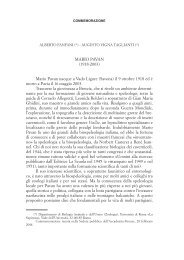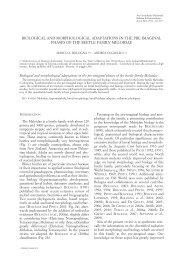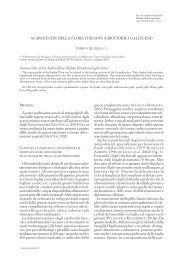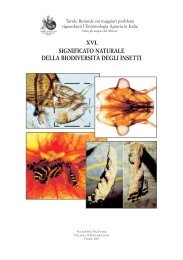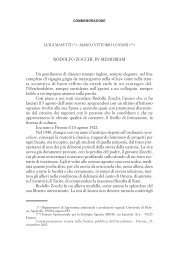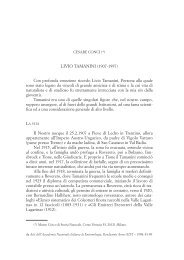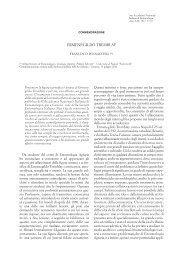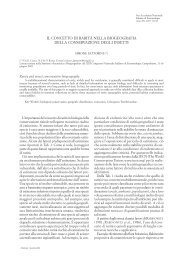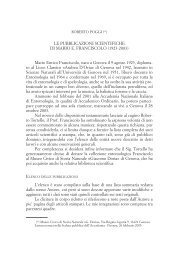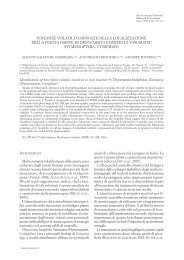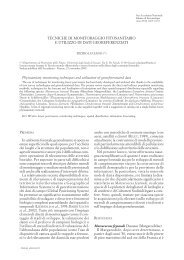XXII CNIE - Accademia nazionale italiana di Entomologia
XXII CNIE - Accademia nazionale italiana di Entomologia
XXII CNIE - Accademia nazionale italiana di Entomologia
You also want an ePaper? Increase the reach of your titles
YUMPU automatically turns print PDFs into web optimized ePapers that Google loves.
ALIEN INSECT SPECIES IN A WARMER WORLD – PATTERNS<br />
AND TRENDS<br />
Alain Roques and Christelle Robinet<br />
INRA UR 633, Zoologie Forestière, Ardon, CS 40001, 45075 Orléans Cedex, France<br />
Climate change and biological invasions are key processes affecting bio<strong>di</strong>versity and<br />
ecosystem services (Sala et al. 2000). However, until now their effect on bio<strong>di</strong>versity has<br />
almost exclusively been targeted independently. Moreover, there are good scientific<br />
reasons to expect the rate and extent of biological invasions to increase under climate<br />
change (Simberloff 2000, Ward and Masters 2007). Hence, the various drivers of global<br />
change in general and climate change and biological invasions in particular, should be<br />
considered in a more integrated manner.<br />
Mean global temperature has increased by ca. 1°C since the pre-industrial era with an<br />
acceleration during the last decades where 8 out of the 10 years between 1996 and 2007<br />
were among the warmest ones since 1850 (EEA, 2008). Thus, climatic isotherms have<br />
moved northwards of 120 km on the average during the past century (Parmesan et al.,<br />
1999). Taking into account <strong>di</strong>fferent change in concentration of greenhouse gases,<br />
climate scenarios pre<strong>di</strong>ct a further range of temperature increase of 1.6- 6.4°C by 2100<br />
(IPCC, 2007). Simultaneous changes in rainfall regimes and in frequency of extreme<br />
climatic events are pre<strong>di</strong>cted. Because insect species are poikilotherm, they are likely to<br />
respond very quickly to temperature changes (Logan et al., 2003). Shifts in climatic<br />
con<strong>di</strong>tions may affect survival, fecun<strong>di</strong>ty, development and <strong>di</strong>spersal, and signs of their<br />
response to global warming have already been detected in native insect species<br />
(Parmesan & Yohe, 2003; Battisti et al., 2005; Parmesan, 2006). Similar to these<br />
observed ecological responses of native species to climate change, climate warming may<br />
<strong>di</strong>rectly influence the introduction and colonisation of alien insect species into new<br />
territories, it may affect their establishment rates and it may also facilitate the spread,<br />
and increase, or decrease the effect of alien species already present in the environment.<br />
Furthermore, an in<strong>di</strong>rect effect of climate change may be realised as some native<br />
ecosystems may become less resistant to invasion under future climates, especially with<br />
regard to drought (see Rouault et al., 2006).<br />
In recent years, there has been an increasing number of reported case stu<strong>di</strong>es showing<br />
that a wide range of alien taxa introduced from warmer climes reproduce and establish in<br />
previously unsuitable areas and as a result enlarge their range of <strong>di</strong>stribution. More than<br />
400 insect species of Australasian, African and Central and South American origin<br />
appeared to have established in Europe, with most of them occurring in the<br />
Me<strong>di</strong>terranean region (Roques et al., 2009). Such a climatically- triggered invasion<br />
process often starts with a few precursor in<strong>di</strong>viduals, which only temporarily occur in a<br />
site during short favourable climatic periods or, in this early stage, are spatially restricted<br />
to favourable micro-habitats. Continued climatic warming may prolong the duration of<br />
these occasional occurrences of initial introductions, increase their frequency or enlarge<br />
the range and area of suitable habitats; thus, making it more likely for these species to<br />
persist, to occur more frequently and to develop larger populations. With further global<br />
warming, alien species originating from wa0rmer regions may build up both numerically<br />
and spatially larger populations that may spread to wider areas.<br />
11



